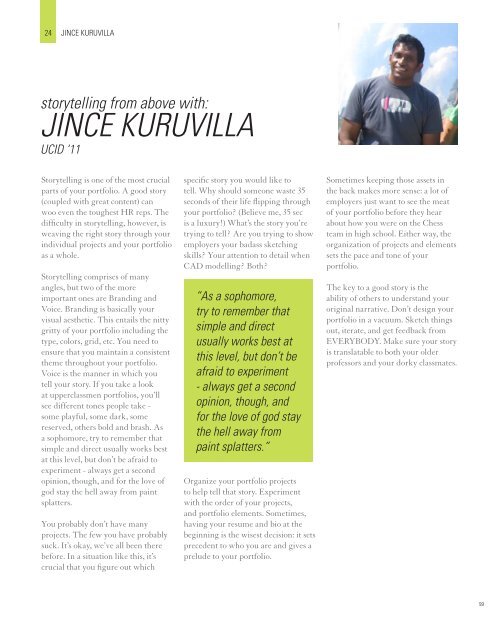HIRE ME?!
HIRE ME?!
HIRE ME?!
You also want an ePaper? Increase the reach of your titles
YUMPU automatically turns print PDFs into web optimized ePapers that Google loves.
24 JINCE KURUVILLA<br />
storytelling from above with:<br />
JINCE kURUVILLA<br />
UCID ‘11<br />
Storytelling is one of the most crucial<br />
parts of your portfolio. A good story<br />
(coupled with great content) can<br />
woo even the toughest HR reps. The<br />
difficulty in storytelling, however, is<br />
weaving the right story through your<br />
individual projects and your portfolio<br />
as a whole.<br />
Storytelling comprises of many<br />
angles, but two of the more<br />
important ones are Branding and<br />
Voice. Branding is basically your<br />
visual aesthetic. This entails the nitty<br />
gritty of your portfolio including the<br />
type, colors, grid, etc. You need to<br />
ensure that you maintain a consistent<br />
theme throughout your portfolio.<br />
Voice is the manner in which you<br />
tell your story. If you take a look<br />
at upperclassmen portfolios, you’ll<br />
see different tones people take -<br />
some playful, some dark, some<br />
reserved, others bold and brash. As<br />
a sophomore, try to remember that<br />
simple and direct usually works best<br />
at this level, but don’t be afraid to<br />
experiment - always get a second<br />
opinion, though, and for the love of<br />
god stay the hell away from paint<br />
splatters.<br />
You probably don’t have many<br />
projects. The few you have probably<br />
suck. It’s okay, we’ve all been there<br />
before. In a situation like this, it’s<br />
crucial that you figure out which<br />
specific story you would like to<br />
tell. Why should someone waste 35<br />
seconds of their life flipping through<br />
your portfolio? (Believe me, 35 sec<br />
is a luxury!) What’s the story you’re<br />
trying to tell? Are you trying to show<br />
employers your badass sketching<br />
skills? Your attention to detail when<br />
CAD modelling? Both?<br />
“As a sophomore,<br />
try to remember that<br />
simple and direct<br />
usually works best at<br />
this level, but don’t be<br />
afraid to experiment<br />
- always get a second<br />
opinion, though, and<br />
for the love of god stay<br />
the hell away from<br />
paint splatters.”<br />
Organize your portfolio projects<br />
to help tell that story. Experiment<br />
with the order of your projects,<br />
and portfolio elements. Sometimes,<br />
having your resume and bio at the<br />
beginning is the wisest decision: it sets<br />
precedent to who you are and gives a<br />
prelude to your portfolio.<br />
Sometimes keeping those assets in<br />
the back makes more sense: a lot of<br />
employers just want to see the meat<br />
of your portfolio before they hear<br />
about how you were on the Chess<br />
team in high school. Either way, the<br />
organization of projects and elements<br />
sets the pace and tone of your<br />
portfolio.<br />
The key to a good story is the<br />
ability of others to understand your<br />
original narrative. Don’t design your<br />
portfolio in a vacuum. Sketch things<br />
out, iterate, and get feedback from<br />
EVERYBODY. Make sure your story<br />
is translatable to both your older<br />
professors and your dorky classmates.<br />
GETTING STARTED<br />
01 99


